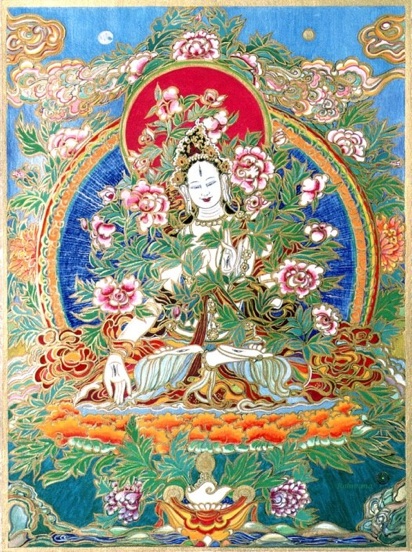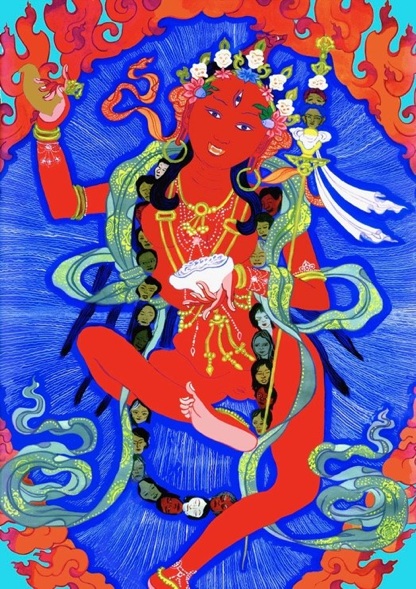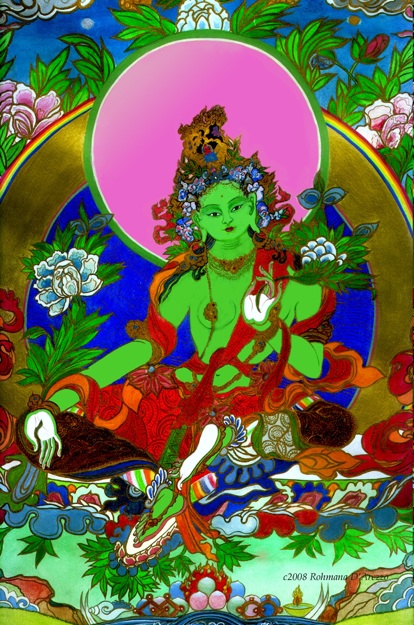ROHMANA D’AREZZO

manacraftgoddessarts
THANGKA PAINTING
Rohmana began her study and apprenticeship of Thangka Painting at Naropa Institute in Boulder, Colorado, under the tutelage of Vidyadhara Chogyam Trungpa, with the master tikse drawing and thangka painter Glen Eddy, and master colorist Terris Temple.
Thangkas are traditional Tibetan painted tapestries which are designed to support
meditation. They contain images of deities and religious figures representing spiritual and historical events. Originally they were painted on monastery and temple walls as frescos.
The making of a thangka begins with preparing the canvas, a natural fiber cloth that is sewn and stretched on to a frame and stiffened with rabbits’ skin glue. The canvas is then coated with gesso, a mixture of lime and chalk, and polished with a shell. Pigment colors are made by grinding minerals such as lapis lazuli, cinnabar, malachite, etc. in accordance with traditional recipes.
The painting begins by making a grid for the proportional drawing. The measurements are achieved by using a small bamboo stick marked with measured spaces. The completed drawing is outlined in black with a brush. Some of the brushes used for detail are very small having only 3 hairs. The details and dimensions are in strict accordance with mathematical measurements from the lineage school that is followed. When the painting is complete it is outlined in gold leaf. And finally the eyes are painted.
The Thangka is framed with 3 layers of different colored silk brocade sewn together.
At the top of the canvas, a wood finial is placed. Red and yellow cloth is sewn around the finial and used to fold over the painting, protecting its surface. It can then be rolled like a scroll, and is portable.
When complete the thangka painting is blessed and inscribed with prayers
by the Buddhist teacher. A small window is left open at the back of the canvas
to be able to view the prayer.
Gouache with gold leaf 20 x 26 in :: 50.8 x 71.2 cm
GREEN TARA
Tara is the manifestation of the wisdom, compassion, love and in particular
the skillful activity of all enlightened beings. Each detail of her image represents a
different aspect of the Buddhist path. Her green color symbolizes her ability to
act. Her right hand is in the gesture of granting sublime realizations. Her left
hand is in the gesture of taking refuge in the three jewels: the buddha, the dharma
and the sangha. Prayers and aspirations are made to Tara the Liberator for overcoming
problems and achieving success.
Gouache with gold leaf 18 x 26 in :: 45.72 x 66.04 cm
WHITE TARA
The goddess White Tara is an enlightened being who has attained the
state called liberation. She is holding the lotus in her left hand, over her heart
in the gesture of pure compassion. She has eyes on the soles of her feet, her hands,
and her forehead, all symbolizing that she responds to thew suffering of the
world. Devotional prayers are offered to White Tara for healing of illness and
to promote long life.
Gouache with gold leaf 20 x 30 in :: 50.8 x 76.2 cm
DORGE PAGMO
In the Tibetan language a Dakini is called Khadro, which translates sky- goer.
She is a divine intermediary between the worlds who has access to a transcendental
buddha. The Dakini can pass insights from the buddha to the seeker. She has many
tasks and different intentions and therefore can appear as a human being; as a goddess,
either peaceful or wrathful; or she may be perceived as the play of energy in the
phenomenal world. Dorje Pag Mo (Vajravarahi) is a symbol of her female tantric
aspect of the buddha. Five of her emanations are known as the five Wisdom Deities.
c2025 Rohmana D’Arezzo / manacraftgoddessarts
Thangka Painting / Visionary Art/ All Rights Reserved


